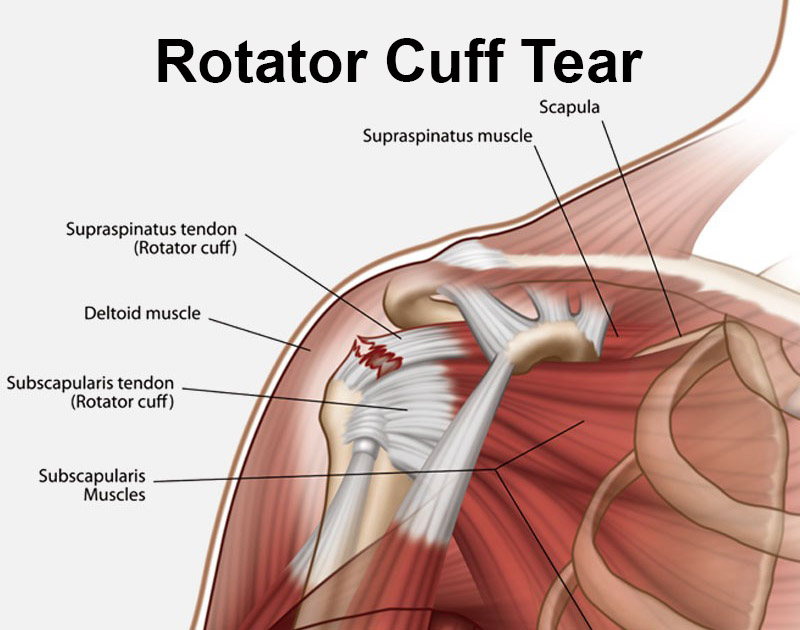Rotator Cuff Injury: Symptoms, Causes, Treatment
What are the symptoms of a rotator cuff injury?
A rotator cuff injury can cause a variety of symptoms, which can range from mild to severe depending on the extent of the injury. Common symptoms of a rotator cuff injury include:
- Pain: Pain in the shoulder is the most common symptom of a rotator cuff injury. The pain may be felt deep in the shoulder and can radiate down the arm. The pain may worsen when lifting or lowering the arm, or when lying on the affected shoulder.
- Weakness: Weakness in the shoulder or arm can occur as a result of a rotator cuff injury. This may make it difficult to lift or rotate the arm, or to perform daily activities that require shoulder movement.
- Difficulty with Arm Movements: People with a rotator cuff injury may have difficulty performing certain arm movements, such as reaching overhead, reaching behind the back, or lifting objects.
- Cracking or Popping Sensation: Some people with a rotator cuff injury may experience a cracking or popping sensation in the shoulder when moving the arm.
- Stiffness: Stiffness in the shoulder joint is common with a rotator cuff injury, especially in the morning or after periods of inactivity.
- Swelling and Tenderness: Swelling and tenderness in the shoulder area may occur, especially if the injury is accompanied by inflammation.
- Limited Range of Motion: A rotator cuff injury can lead to a limited range of motion in the shoulder joint, making it difficult to move the arm in certain directions.
It’s important to seek medical attention if you experience symptoms of a rotator cuff injury, as early diagnosis and treatment can help prevent further damage and improve recovery. Treatment may include rest, physical therapy, medication, or in some cases, surgery.
What are the causes of a rotator cuff injury?
Rotator cuff injuries can occur due to a variety of reasons, including acute injuries, chronic overuse, and degenerative changes. Some common causes of rotator cuff injuries include:
- Acute Trauma: A sudden, forceful impact or trauma to the shoulder, such as a fall onto an outstretched arm or a direct blow to the shoulder, can tear the rotator cuff muscles or tendons.
- Repetitive Overuse: Repetitive overhead arm movements, such as those performed in sports like baseball, tennis, or swimming, or in occupations that require repetitive lifting or reaching overhead, can lead to overuse injuries of the rotator cuff.
- Poor Posture: Poor posture, especially when sitting or standing for long periods with rounded shoulders, can lead to muscle imbalances and increased strain on the rotator cuff muscles, increasing the risk of injury.
- Aging and Degeneration: As we age, the tissues of the rotator cuff tend to degenerate and become less flexible, making them more prone to injury. Degenerative changes can lead to conditions like rotator cuff tendinitis or rotator cuff tears.
- Lack of Muscle Strength and Flexibility: Weakness or lack of flexibility in the muscles around the shoulder joint can increase the risk of rotator cuff injuries.
- Bone Spurs: Bone spurs, or osteophytes, can develop on the acromion (the bony projection of the scapula that forms the roof of the shoulder joint) and impinge on the rotator cuff tendons, leading to irritation and tears.
- Other Factors: Other factors that can increase the risk of rotator cuff injuries include family history of rotator cuff problems, certain medical conditions (such as diabetes or thyroid disorders), and smoking, which can impair blood flow to the rotator cuff tendons.
It’s important to take steps to prevent rotator cuff injuries by maintaining good posture, strengthening and stretching the shoulder muscles, using proper techniques when lifting or performing overhead activities, and avoiding repetitive movements that strain the rotator cuff. If you suspect you have a rotator cuff injury, it’s important to seek medical attention for proper diagnosis and treatment.
What is the treatment for a rotator cuff injury?
The treatment for a rotator cuff injury depends on the severity of the injury. For mild cases, rest, ice, and over-the-counter pain medications may be sufficient. Physical therapy can also help strengthen the shoulder muscles and improve range of motion.
For more severe cases, especially those involving a tear in the rotator cuff, surgery may be necessary. The type of surgery depends on the extent of the injury and may include arthroscopic repair, open surgery, or a combination of both.
In some cases, corticosteroid injections may be used to reduce inflammation and relieve pain, but these are typically used in conjunction with other treatments.
It’s important to consult with a healthcare professional for an accurate diagnosis and appropriate treatment plan for a rotator cuff injury.




